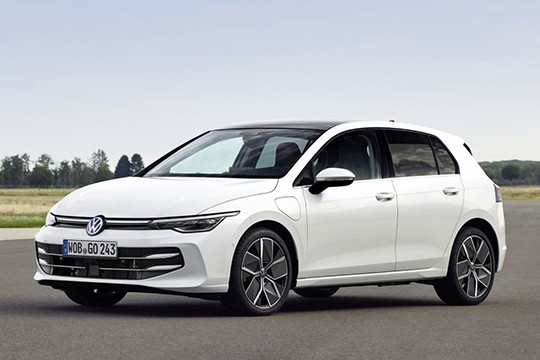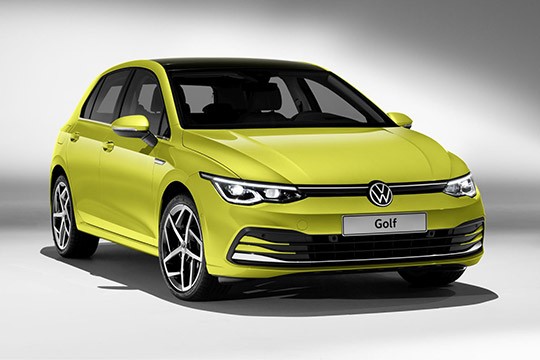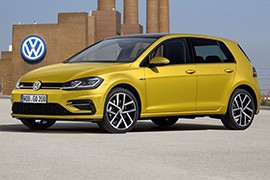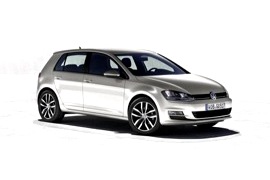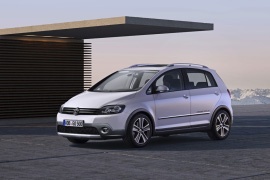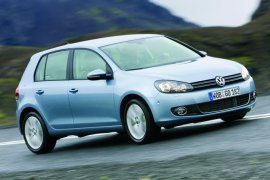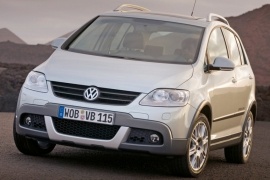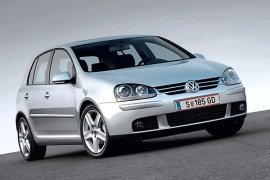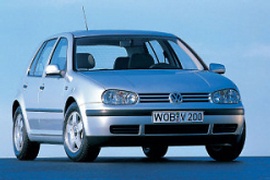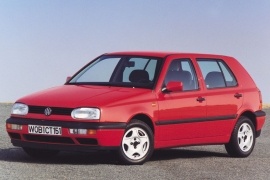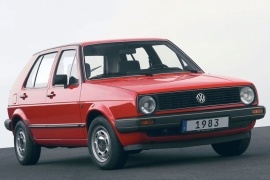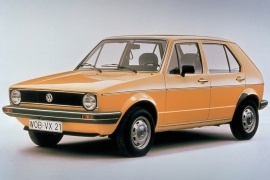VOLKSWAGEN Golf 5 Doors Models/Series Timeline, Specifications & Photos
First production year: 1974
Engines: Hybrid, Gasoline, Diesel, Natural gas
Body style: Hatchback
Volkswagen refreshed the eighth generation of its famous model Golf in 2024, half a century after the nameplate's introduction in 1974.
With more than 37 million units sold, the Golf is the most important nameplate in the compact-sized segment of the vehicles. The first generation's production had started back in March 1974, but the car was two months later. Meanwhile, there were no less than eight generations of this moniker. Even though there were many other significant competitors on the market, which outsold the Golf in 2023, Volkswagen's compact-sized vehicle was still the best-known model in its class.
Volkswagen knew that the front fascia of the Golf 8.5 should sport a significant design element that could make it stand apart from the crowd. As a result, it offered an illuminated logo on the upper grille as an option. Moreover, it installed a horizontal LED stripe above it, which visually connected the LED headlights. Depending on the grade, the Golf was available with either a regular lower bumper that sported a three-slat grille while those fitted with the S-Line package featured an aggressive apron with a honeycomb mesh on it resembling the performant GTI model.
From its profile, the Golf 8.5 wasn't that much different from its predecessor. Still, depending on the engine version, it sported a wide logo under the front door mirrors. Volkswagen offered the Golf 8.5 in four grades: Golf, Life, Style, and R-Line. Above these, there were the GTE and the GTI versions, which had their specific features since those were more potent. Just like its non-facelifted sibling, it was available as a five-door option. All versions had alloy wheels starting with 17 inches in size, with options for up to 19 inches. At the back, the Golf had two options for LED taillights.
Inside, the automaker installed a standard 10.2-inch screen inside the instrument cluster. Drivers could customize the information displayed depending on their preferences. They could do that via the buttons on the steering wheel. Volkswagen listened to its customers who complained about the touch buttons used on the Golf 8 and fixed that issue with the facelifted version. Atop the center stack, the car was offered with a standard 10.4-inch touch screen, with an option for a 12.9-inch one. Unfortunately, Volkswagen seemed to have missed the memo where most buyers complained about the lack of turn-volume knob or about the sliders needed to control the HVAC, so it left them the same way. The only change was that the sliders were now permanently illuminated.
Under the hood, the automaker installed a wide choice of engines. It offered the Golf with either gasoline, mild-hybrid, or plug-in hybrid versions. Moreover, it still offered the Golf with turbo diesel powerplants, an option that seemed to be very attractive to its buyers. Power was sent to the front wheels only via either a six-speed manual or a seven-speed automatic (dual-clutch) gearbox. Depending on the power level, the Golf 8.5 featured a torsion beam or an independent suspension at the back.
Volkswagen had been producing the Golf VII for 5 years now, and the Golf VIII is a very important model. It shares the same chassis with its older brother, and we could say that the Golf VIII’s interior looks pretty avant-garde, having two large touchscreens. They can be used with gesture controls as well. The rather clean design has no physical buttons and is equipped with touch sensitive surfaces.
For the automatic transmission, the regular lever has been replaced by a little paddle. In front of the paddle there’s a surface that allows wireless charging for the phone. The infotainment system has sharp graphics and the driver and passengers can connect their drives via the Apple Car play or the Android Auto. For Android users, the device can only be connected with a wire. Voice commands are also available for this model. For example, the driver could ask the intelligent system to start heating the seat(s).
The car can also be equipped with Automatic Park Assist, Adaptive Cruise Control with predictive speed detection. The new Golf is super easy to drive and has good visibility. The steering is both nice and light. It is equipped with progressive brakes, but very efficient in case of emergency.
The adaptive suspension can be chosen as an option and the suspension’s stiffness can be manually modified. Ambient colors are also an option and have multiple pre-defined combinations.
Escaped by the Dieselgate and by the world financial crisis, Volkswagen created another successful sequel for the Golf. It introduced the seventh generation in 2012, which it facelifted five years later.
While the sixth Golf generation was closer to an ample facelift than to a completely new model, since it featured the same platform as the Golf's fifth generation, the 2012 model was new from tip to toe. Volkswagen built it on top of the MQB platform used on all of its brands (Volkswagen, Audi, Seat, and Skoda). In 2017, the German carmaker introduced a facelifted version for the Golf VII.
Its sharper look was far more distinct than on the sixth-generation model. The angular headlights featured LED daytime running lights inside them, and Volkswagen offered an option for Full-LED headlamps. The narrow grille between them sported two slim slats and the chromed VW badge. A trapezoidal-shaped lower grille in the bumper made the car looks more aggressive. On the sides, the five-doors version sported a black B-pillar and door frames, creating the impression of a three-door vehicle, but the carmaker left the rear door handles on the door panels, not hidden. At the back, all versions received LED taillights.
Inside, the carmaker installed an interior that looked more premium than mass-market. Volkswagen improved the materials on the soft-touch dashboard, the upholstery, and the center stack. As an option, the Golf VII featured a 12.3" digital instrument cluster. A new, Discover-Pro, 9.2" touch-screen became available on the options list, enhancing the driving experience.
Under the hood, Volkswagen installed Euro 6 compliant engines ranging between 85 hp and 150 hp, either gasoline or diesel. All versions were turbocharged. For the transmission, the carmaker opted either for a six-speed manual or a seven-speed automatic (double-clutch) gearboxes.
VOLKSWAGEN Golf VII 5 Doors 1.0L TSI 5MT (85 HP)
VOLKSWAGEN Golf VII 5 Doors 1.0L TSI 6MT (110 HP)
VOLKSWAGEN Golf VII 5 Doors 1.0L TSI 7AT (110 HP)
VOLKSWAGEN Golf VII 5 Doors 1.4L TSI 6MT (125 HP)
VOLKSWAGEN Golf VII 5 Doors 1.4L TSI 6MT (150 HP)
The seventh Golf arrived in 2012 and, after 29 million units sold around the world from its previous generations, was expected to be something special. It brought the new MQB platform, which was a great idea to cut costs, install various features on the car and make it lighter.
At 4255 mm (13.9 ft), the seventh Golf was 56 mm (2.2”) longer than its predecessor, with a 59 mm (2.3”) longer wheelbase of 2,637 mm. The front wheels were 43 mm (1.7”) further forward, helping to generate more interior space, especially for the rear passengers. Also, the Golf was lowered and a little bit wider, and the overall drag coefficient was lowered to a Cd of 0.29.
Inside, the new interior was more attractive, more driver-oriented. The central console was angled more towards the driver, with easier access to the buttons and infotainment system. It features a standard 5.8” touchscreen display and an 8” unit with navigation system was on the options list. Automatic climate control was not standard on all the range, but most of them did have that.
For the drivetrain, a semi-rigid suspension was standard on vehicles with less than 115 hp diesel and 125 hp gasoline engines but it featured fully independent suspension for all the others.
The Golf was available with gasoline, compressed natural gas, diesel, electric and plug-in hybrid versions. It featured manual and automatic (dual-clutch) transmission, front or all-wheel-drive.
VOLKSWAGEN Golf VII 5 Doors 1.2L TSI BlueMotion 5MT FWD (85 HP)
VOLKSWAGEN Golf VII 5 Doors 1.2L TSI BlueMotion 6MT FWD (110 HP)
VOLKSWAGEN Golf VII 5 Doors 1.2L TSI BlueMotion 7AT FWD (110 HP)
VOLKSWAGEN Golf VII 5 Doors 1.4L TSI ACT BlueMotion 6MT FWD (150 HP)
VOLKSWAGEN Golf VII 5 Doors 1.4L TSI ACT BlueMotion 7AT FWD (150 HP)
VOLKSWAGEN Golf VII 5 Doors 1.4L TSI BlueMotion 6MT FWD (125 HP)
VOLKSWAGEN Golf VII 5 Doors 1.4L TSI BlueMotion 6MT FWD (150 HP)
VOLKSWAGEN Golf VII 5 Doors 1.4L TSI BlueMotion 7AT FWD (125 HP)
VOLKSWAGEN Golf VII 5 Doors 1.4L TSI BlueMotion 7AT FWD (150 HP)
VOLKSWAGEN Golf VII 5 Doors 1.6L TDI 4Motion 6MT AWD (110 HP)
VOLKSWAGEN Golf VII 5 Doors 1.6L TDI BlueMotion 5MT FWD (110 HP)
VOLKSWAGEN Golf VII 5 Doors 1.6L TDI BlueMotion 7AT FWD (105 HP)
VOLKSWAGEN Golf VII 5 Doors 2.0L TDI 4Motion 6MT AWD (150 HP)
VOLKSWAGEN Golf VII 5 Doors 2.0L TDI BlueMotion 6AT FWD (150 HP)
VOLKSWAGEN Golf VII 5 Doors 2.0L TDI BlueMotion 6MT FWD (150 HP)
Volkswagen introduced the facelifted version for the CrossGolf at the 2010 Geneva Motor Show and upgraded the car to Euro 5 standards.
With an increased demand for crossovers and SUVs on the market, Volkswagen couldn’t stay put and not showing anything. Yet, it was not completely ready with a new vehicle range and had to rely on existing projects.
The CrossGolf was a lifted version of the Golf Plus, an MPV built on top of the well-known compact hatchback. Volkswagen revised the car’s front fascia, where the carmaker introduced the “Design DNA” concept with horizontal lines over the grille reflected into the horizontal form of the bumper. The mirror caps were painted in silver, as on any other Cross model from Volkswagen.
Inside, the carmaker built the CrossGolf as a minivan, and thus it offered plenty of space. Volkswagen installed, specific for the CrossGolf, doorstep inserts with an aluminum-look on the front doors. The headroom was more than enough even for tall people and, due to the raised seating position, the car was roomy enough even for the rear passengers. All these resulted due to the vehicle’s tall greenhouse. Last but not least, a large trunk could accommodate up to 1,450 liters (51.2 cu-ft) of luggage with the rear, split-folding seats out of the way.
Along with the facelift, Volkswagen introduced the Euro 5 engines for the CrossGolf in both versions: gasoline or turbodiesel. Apart from a 1.6-liter bi-fuel option (gasoline and CNG) mainly for fleet usage, all other engines were turbocharged. A new automatic (dual-clutch) gearbox was available at extra cost for specific engine versions, while the classic, six-speed automatic transmission as an option exclusively for the 2.0-liter TDI powerplant.
VOLKSWAGEN CrossGolf 1.6L Bifuel - Natural Gas 5MT FWD (98 HP)
Volkswagen introduced the sixth generation of the Golf in 2008 with three and five doors, at a time when the car industry was going down due to the world financial crisis.
There were difficult times for automakers, and some considered that they should stay put and postpone any new models until the economy bounced back. But Volkswagen didn't want to wait. The idea behind the project was, as VW's head of design, Mr. Walter da Silva stated, "to create an iconic car for the future."
From the outside, the 2008 Golf featured a three-slats design for the grille and rounded swept-back headlights. The apron was complemented with the fog lights on the outboard and a wide, trapezoidal, black grille. The five-door version was a very practical vehicle for those who needed rear seats for children or teenagers. In addition, the rear doors featured narrower windows that could completely roll down. Finally, at the back, the Golf VI got a sharper design for the taillights, with horizontal reversing lights extended from the rear quarter panels onto the tailgate.
The dashboard featured an instrument cluster with a design inspired by the Passat CC. It sported two big dials and two smaller ones, placed inside the former ones. A center stack with the infotainment system and a big area reserved for the climate controls, inspired by the VW Passat CC. The bucket seats were typical for the entire Volkswagen range. The rears split-folding bench could host up to three adults, but not for long distances.
The Golf was offered with a wide choice of engines. There were five gasoline units, five turbodiesels, and 1 with CNG. The latter was fit for fleet users. The standard transmission was a 5- or 6-speed manual depending on the engine. A 7-speed automatic was offered for diesel and gasoline versions, and an all-wheel drive system was also on the options list.
VOLKSWAGEN Golf VI 5 Doors 1.2L TSI 5MT FWD (85 HP)
VOLKSWAGEN Golf VI 5 Doors 1.2L TSI 6MT FWD (105 HP)
VOLKSWAGEN Golf VI 5 Doors 1.2L TSI 7AT FWD (105 HP)
VOLKSWAGEN Golf VI 5 Doors 1.4L 16V 5MT FWD (80 HP)
VOLKSWAGEN Golf VI 5 Doors 1.4L TSI 6MT FWD (122 HP)
VOLKSWAGEN Golf VI 5 Doors 1.4L TSI 6MT FWD (160 HP)
VOLKSWAGEN Golf VI 5 Doors 1.4L TSI 7AT FWD (122 HP)
VOLKSWAGEN Golf VI 5 Doors 1.4L TSI 7AT FWD (160 HP)
VOLKSWAGEN Golf VI 5 Doors 1.6L 5MT FWD (102 HP)
After two years since the launch of the Xterra's first generation, Nissan unveiled the facelifted version for it at the Chicago Auto Show.
Nissan counted on its off-road experience when it made the Xterra. It was built on the same chassis as the Frontier pickup and was related to the European Pathfinder. It aimed at the X-generation, hence the X in its name, and tried to convince its customers that it could deal with more rugged terrain than its competitors. But being related to a utility vehicle came with a similar steering system cost and being heavier than other compact-segment SUVs.
The revised Xterra received a new front fascia with a V-shaped grille similar to other Nissan vehicles. Yet, its round headlights in squared clusters looked odd for a car launched in 2001. The flared wheel-arches for both axles made room for big, 265/65R 17 tires for the SE version and 265/70R 16 for the rest of the range. A new, 48 mm (1.9") bulge on the hood made room for a supercharger for the most potent version.
Inside, the carmaker introduced a new instrument panel with three round dials with the speedometer in the middle and the tachometer on the left. At the same time, the right cluster featured the fuel level and coolant temperature gauges. In addition, the redesigned center stack sported a side map pocket, while the glove compartment grew by 25%.
But the most significant changes were under the hood, where the carmaker offered a choice of three engines ranged between 143 hp and 210 hp. The latter was a supercharged V-6 powerplant, and it was available with a five-speed manual gearbox. In addition, depending on the options, Nissan installed either an open or a limited-slip differential for the rear axle.
Volkswagen introduced the fifth Golf generation in 2003, replacing the older MK 4 lineup, and it stayed on the market just six years before being replaced by its successor, the Golf MK 6.
The Golf might be the best-known Volkswagen globally. Apart from the U.S. market, where it was sold under Rabbit name, the rest of the world received the Golf nameplate. Its fifth-generation was rounded even more than its predecessor.
Its exterior was not too daring, with clear-lenses over the dual headlamps and turn-signals of each headlight. The grille featured two slats that supported the chromed badge big enough to fill the space between the hood and the bumper. On its sides, the carmaker installed body-colored door handles and mirrors with turn-signals at the bottom.
Inside, Volkswagen offered a two-tone interior only for specific versions, while the Trend trim-level featured only the bland black-and-gray color scheme. Inside the instrument cluster, the carmaker installed a red-on-black LCD between the speedometer and tachometer, while the fuel level and temperature gauges were moved at the bottom of the instrument panel. Its flat seats offered as standard didn't provide too much grip for their occupants, but Volkswagen offered a better pair for extra money. In the back, the split-folding rear bench seatback could expand the trunk area.
Under the hood, Volkswagen installed a very wide range of engines for the Golf. It offered both gasoline and turbo-diesel units. The latter were blamed for their fake results in the Emission tests that started the Dieselgate scandal.
VOLKSWAGEN Golf V 5 Doors 1.4L 5MT FWD (75 HP)
VOLKSWAGEN Golf V 5 Doors 1.4L FSI 5MT FWD (90 HP)
VOLKSWAGEN Golf V 5 Doors 1.4L TSI 6MT FWD (122 HP)
VOLKSWAGEN Golf V 5 Doors 1.4L TSI 6MT FWD (140 HP)
VOLKSWAGEN Golf V 5 Doors 1.4L TSI 6MT FWD (170 HP)
VOLKSWAGEN Golf V 5 Doors 1.6L 5MT FWD (75 HP)
Volkswagen introduced the fourth generation of the Golf as more of an evolution than a revolution to its compact hatchback family.
The Golf's third generation was received with mixed feelings by its fans since it was the first to sports a different shape with rounded corners and a softened look. But Volkswagen was right, and its sales exceeded the second generation. For the 1997 model, the German carmaker decided to improve the third generation and made one of the best Golf versions ever. Indeed, it was the best until then.
The exterior kept the same rounded shape as its predecessor and looked like the carmaker didn't want to go back for the wedged-style again. It was 1997, and the biodesign trend covered most of the market. Its rounded headlights grouped all the lights it could. That led to additional turn-signals on the front fenders to comply with various safety regulations around the world. Unlike its three-door sibling, the five-door version featured shorter front doors.
Inside, the five-door version featured different front seats than its 3-door sibling. Inside, the dashboard featured an instrument cluster with back-lit dials. An LCD took center stage between the tachometer and speedometer. On the center stack, Volkswagen offered an option for an infotainment's system display.
Volkswagen installed a wide choice of engines for the Golf, starting with a 1.4-liter unit and going up to the fierce VR6 model that sent 204 hp to all corners.
VOLKSWAGEN Golf IV 5 doors 1.4L 5MT FWD (75 HP)
VOLKSWAGEN Golf IV 5 doors 1.6L 5AT FWD (100 HP)
VOLKSWAGEN Golf IV 5 doors 1.6L 5MT FWD (105 HP)
VOLKSWAGEN Golf IV 5 doors 1.6L FSI 5MT FWD (110 HP)
VOLKSWAGEN Golf IV 5 doors 1.8L 5MT FWD (125 HP)
VOLKSWAGEN Golf IV 5 doors 1.8L Turbo 5MT FWD (150 HP)
VOLKSWAGEN Golf IV 5 doors 2.0L 5MT FWD (155 HP)
VOLKSWAGEN Golf IV 5 doors 1.9L SDI 5MT FWD (68 HP)
VOLKSWAGEN Golf IV 5 doors 1.9L TDI 5MT FWD (100 HP)
VOLKSWAGEN Golf IV 5 doors 1.9L TDI 5MT FWD (110 HP)
VOLKSWAGEN Golf IV 5 doors 1.9L TDI 5MT FWD (90 HP)
VOLKSWAGEN Golf IV 5 doors 1.9L TDI 6MT FWD (115 HP)
Volkswagen unveiled the Golf's third generation in the summer of 1991, and the sales started with the three- and five-door versions.
The third generation came after a highly successful Golf II sold in more than six million units globally. At first, it was a shock since it didn't follow the same design language as its predecessor, slowing down its sales. Another drawback for the car's evolution was the destruction of the TAS factory from Sarajevo, which affected the car's price. The third generation of the German hatchback brought the first European Car of The Year award for Volkswagen.
Unlike the second generation, which followed the same design language as its predecessor, the third Golf featured rounded shapes and horizontal headlights with a rounded interior side. The grille was smaller, and the bumpers got bigger, stretched from one wheel-well to another. Volkswagen made the car with a thick C-pillar behind the rear doors, which diminished the driver's visibility compared to the Golf's second generation.
Inside, Volkswagen installed a curved dashboard with a taller, tilted toward the driver, center stack. The instrument cluster kept a similar layout with four dials, but the carmaker introduced a small LED display at the bottom. For the base trim levels, the Golf III featured cranked windows and manually adjustable door mirrors. The upper trim levels featured power mirrors, windows and locks, and AC. Volkswagen installed a split-folding bench in the rear and offered surprisingly good room for up to three adults, and, thanks to the rear doors, it provided an easier ingress and egress from the car.
Volkswagen installed a wide range of powertrains with front or all-wheel-drive systems. Power ranged between 60 hp and 190 hp for the gasoline versions and 64 hp to 110 hp for the diesel ones. The full-spec VR6 version was available with an all-wheel-drive system named Syncro.
VOLKSWAGEN Golf III 5 Doors 1.4L 5MT FWD (60 HP)
VOLKSWAGEN Golf III 5 Doors 1.6L 5MT FWD (100 HP)
VOLKSWAGEN Golf III 5 Doors 1.6L 5MT FWD (75 HP)
VOLKSWAGEN Golf III 5 Doors 1.8L 5MT FWD (75 HP)
VOLKSWAGEN Golf III 5 Doors 1.8L 5MT FWD (90 HP)
VOLKSWAGEN Golf III 5 Doors 2.0L 5MT FWD (115 HP)
VOLKSWAGEN Golf III 5 Doors 2.8L V6 VR6 5MT FWD (174 HP)
VOLKSWAGEN Golf III 5 Doors 2.9L VR6 Syncro 5MT AWD (190 HP)
Volkswagen introduced the second generation of the Golf at the 1983 Frankfurt Motor Show, and it was more of an evolution than a revolution.
The new model looked very similar to its predecessor, but it was bigger. Apart from the height, it was like a 110% Golf I. But its wide engine choice and the form-follow-function theme won the buyers' hearts. In its nine years of production, the Golf's second generation was sold in over six million units. The five-door version was better suited for young families, without children or with smaller ones.
For Europe, the Golf II sported round headlights and a wedged shape that was easy to recognize. The U.S. customers received a slightly different version, with squared headlights and a similar black slatted grille. Both versions featured plastic, wrapped-around bumpers front, and rear, albeit the U.S. version provided fatter ones to pass the safety standards. Unlike its predecessor, the second generation was available in a three or five-door version right from its launch.
Inside, the carmaker installed an angular-looking dashboard, and a squared instrument cluster extended the center stack. For the base trim level, the Golf featured a speedometer and a clock, with an option for a tachometer. The upper trim levels and the GTI were available with a trip computer, either as an option or standard. In the back, the carmaker installed a folding rear bench to expand the trunk size. A 60/40 split-folding system was on the options list and standard for the GTI.
Under the hood, Volkswagen offered a small range of engines, either gasoline or diesel. An automatic transmission was available for specific versions.
While the Italian and the French carmakers were enjoying great success with their Fiat 124 and the Peugeot 504, Volkswagen was stuck with the already dated Beetle.
Thus, the German carmaker was in great need of a new product to replace the famous people’s car.
Different prototypes were produced starting with early 1950s, but only one of the development projects was considered the basis of the new Golf, the EA337.
Kurt Lots, Volkswagen’s Director General, visited the 1969 Turin Auto Show and selected his favorite cars, 4 out of 6 being designed by Giorgetto Giugiaro.
Giugiaro was invited to work on the project EA337, VW providing him with the basic dimensions and the power-train options.
Giurgiaro’s “folded-paper” design featured sharp corners, flat panels, rectangular headlamps and wide tail-lamps. By the time the Golf I entered production, the definitive version featured round headlamps and narrower rear lamps.
Even though the Golf I was designed as a successor to the Beetle, the new model was actually completely different in terms of mechanicals: VW shifted from the rear-wheel drive and the rear-mounted air-cooled engines to a front-wheel-drive system and a water cooled powerplants. With the engine transversely mounted ahead of the front axle, the space created within the footprint of the car allowed maximum use.
While the Beetle had a traditional chassis and a body two-piece construction, the VW Golf I featured a monocoque design.
Two of the four available powerplants were borrowed from Audi, while the other 2 were part of the original EA111 development project. Their power ranged from 50 hp to 70 hp.
